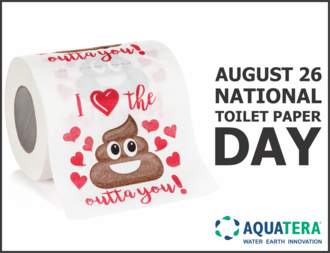
At the onset of the COVID-19 pandemic, store shelves were quickly emptied of toilet paper, revealing the commodity’s prominent, yet unspoken role in modern-day society. Although humans have cleaned their bottoms for as long as they have walked the Earth, “three-ply” and “extra-soft” didn’t always describe toilet hygiene. Before the introduction of mass-produced, commercially available toilet paper in the mid-1800s, and the continued improvements made into the early 20th century, people relied on less luxurious ways to wipe their bottoms.
On August 26, we celebrate National Toilet Paper Day. This represents the anniversary of the day the first roll of toilet paper was sold in 1871. Naturally, I had to do a deep dive on the history of toilet paper, and I learned some pretty interesting facts about this commodity that too often we take for granted.
People Were Creative
Before we had access to modern-day toilet paper, people had creative and sometimes dangerous ways of cleaning up. Toilet paper substitutes included corn cobs, ferns, moss and fruit peels, as well as broken pottery, seashell, stones and sponges.
Status Dictated Wiping Tools
In the middle ages, wealthy people would wipe with rosewater-soaked wool or lace while less wealthy people would use the tools mentioned above, or a gompf stick that would be shared communally. As you can imagine, less wealthy people were more susceptible to injury and disease.
Oh, the Shame!
When toilet paper was first introduced, consumers were embarrassed to be seen purchasing it due to its purpose. But the game changed in the 1920’s when Hoberg Paper Company introduced Charmin. The company used a photo of a beautiful woman to make the toilet paper look soft and alluring and the strategy worked!
Flushing Time
Toilet paper is one of the 4 P’s because it is specifically designed to decompose. The fibers used to make toilet paper are very short, which allows the paper to start disintegrating seconds after it gets wet. Other paper products such as tissues, paper towel and wipes are not made of the same materials and don’t dissolve in septic systems.
Accessibility
Seventy-five per cent of the world’s population (approximately four million people) do not use toilet paper because it is too expensive, and they do not have access to sufficient plumbing. How fortunate are we to have toilet paper and proper infrastructure that allows us to access to these services without even having to think about.
Speaking of Expensive
Fancy flushing your hard-earned money down the toilet? For just $1.3 million dollars, you can purchase a single roll of 24-karat gold toilet paper from Toilet Paper Man, a company out of Australia. On a sidenote, this company also sells Chilli Tabasco Toilet Paper, and it is as spicy as it sounds…
The Great Debate
According to the toilet paper patent developed 132 years ago, the illustration confirms that the toilet paper roll must go up and over. Personally, I feel vindicated. Down and under just feels so wrong, and I will not hesitate to put your roll the “right” way if I ever find myself in your washroom.
Who knew toilet paper could be so interesting? As we reflect on National Toilet Paper Day, let’s take a moment to be truly grateful for this product that is comforting and accessible, and be thankful that we’re not sharing a gompf stick…
Leave A Comment